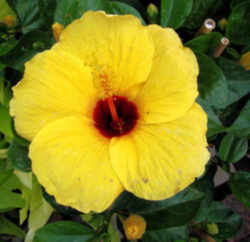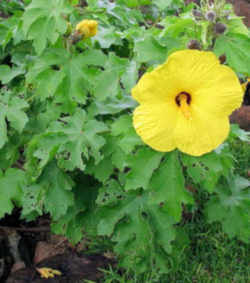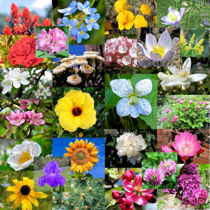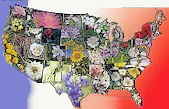
Hawaii Symbols
Hawaii State Flower
Native Yellow Hibiscus

Pua Aloalo or Ma`o-hau- hele
(Hibiscus brackenridgei A. Gray)
Adopted on June 6, 1988.
The striking and beautiful native yellow hibiscus, (Hibiscus brackenridgei,) known as the pua aloalo (also called ma`o-hau-hele) in the Hawaiian language, is the Hawaii state flower.
By act 177, approved on June 6, 1988, the Hawaii Legislature adopted the native yellow hibiscus (Hibiscus brackenridgei A. Gray), also known as the pua aloalo or ma`o-hau-helewas, as the "official flower of the State."
Hawaii State Flower: Native Yellow Hibiscus
History of the Pua Aloalo or Ma`o-hau- hele

Hawaii's state flower originated in Asia and the Pacific islands. Interestingly, it is also the national flower of Malaysia. This species is a true tropical hibiscus belonging to the Malvaceae, or mallow family. It is believed that there were originally only five species of hibiscus native to Hawaii. Later other varieties were imported and growers began to develop hybrids to produce the kaleidoscope of colors and sizes found today.
In 1923 Hawaii was still a territory, and the ilima was adopted as the state's flower following its promotion by an organization called "The Outdoor
Circle." In 1950, when statehood was being anticipated by the Hawaiians, a resolution was introduced stating: "Hawaii's official flower shall be the
ilima, the flower of old royalty." Many Hawaiians felt that the ilima should be the state's flower because the famed ilima leis were always presented
to dignitaries who came to Hawaii. Two other exotic flowers, the lehua and the vanda, were also considered. However, when a vote was taken the ilima
was chosen as the winner.
Hawaii officially became the fiftieth state of America in 1959. The realization that the ilima had never been changed from being Hawaii's territorial
flower to her state flower didn't surface until nearly thirty years later! To solve this problem, the legislature decided to legally adopt the flower
that had for so long been considered official.
Therefore on June 6, 1988, Hawaii changed its state flower from the native red hibiscus (Hibiscus kokio) to the ma'ohauhele, the only species of yellow
hibiscus that can be called our state flower.
Description
Ma'ohauhele is a shrub that grows up to 10 feet, with maplelike leaves and bright yellow flowers. It varies in appearance among islands but generally falls into two subspecies: H. brackenridgei subspecies brackenridge of Maui, Molokai, Lanai and the Big Island, and H. brackenridgei subspecies mokuleianus of Oahu and Kauai.
The most visible difference between the two subspecies is in the leaves and stems. The leaves of subspecies mokuleianus have more serrated margins and pink veins with tiny spines on the branches. Subspecies brackenridgei, on the other hand, has leaves with more rounded margins and yellow veins, and it lacks the tiny spines on its branches.
Does well in full sun to partial shade and needs very little water, although daily watering is OK. It is a fast grower and will flower about twice a year. Each flowering period lasts up to two months, with blooms occurring daily on a flowering stalk that rises above the plant.
Distribution
This is an endangered species found in the dry to mesic forests of all main islands except Niihau (it was once reportedly collected from Kahoolawe).
Facts About Hawaiian hibiscus
- Hawaiian hibiscus shrub grows to a height of 3 to 15 feet tall with a diameter of 8 to 15 feet. Young Hawaiian hibiscus plants have smooth tan trunks; the trunks of older plants have a wrinkled appearance.
- Hawaiian hibiscus flowers are found on all the main Hawaiian islands except Ni'ihau and Kaho'olawe, but the flowers are not common in any location.
- Hawaii changed its state flower from the native red hibiscus (Hibiscus kokio),on June 6, 1988, to the Hawaiian hibiscus - ma'o hau hele, the only species of yellow hibiscus.
- The leaves on Hawaiian hibiscus have toothed edges, 3, 5, or 7 lobes, and are up to 6 inches long and equally wide.
- The seeds of Hawaiian hibiscus are contained in 3/8 to 3/4 inch oval capsules. The capsule is covered with soft hairs. It is dry and tan when mature and opens to release the seeds. The seeds are 1/8 inch long, kidney-shaped, and covered with fine hairs.
- Hawaiian hibiscus flower plants can be grown from cuttings if rooting hormones are used.
- Hawaiian hibiscus bloom from spring through early summer with occasional flowers during the rest of the year.
Official flowers and colors for each island is as follows: 2000
- Hawai`i, Red Lehua (Ohia)
- Maui, Lokelani - Pink Cottage Rose (Rosa damascena)
- Moloka`i, White Kukui Blossom (Aleurites moluccana)
- Kaho`olawe, Hinahina -Beach Heliotrope (Heliotropium anomalum, var. argenteum)
- Lana`i, Kaunaoa -Yellow and Orange Air Plant (Cuscuta sandwichiana)
- O`ahu, Ilima (Sida fallax)
- Kaua'i, Mokihana - Green Berry (Pelea anisata)
- Ni`ihau, White Pupu Shell
Hawaii Revised Statute
The law designating the native yellow hibiscus as the official Hawaii state flower is found in Hawai'i Revised Statutes, Volume 1, Chapter 5, Section 5-16
Volume 1.
CHAPTER 5. EMBLEMS AND SYMBOLS.
SECTION 5-16
§5-16 State flower and individual island flowers. The native yellow hibiscus (Hibiscus brackenridgei A. Gray), also known as the Pua Aloalo or Ma'o-hau-hele,
is established and designated as the official flower of the State.
The 'ohi'a lehua (metrosideros macropus M. collina), also known as the pua lehua, is established and designated as the official flower of the island
of Hawai'i.
The lokelani, also known as the damask rose (rosa damascena), is established and designated as the official flower of the island of Maui.
The pua 'ilima from the native dodder shrubs (sida fallax) is established and designated as the official flower of the island of O'ahu.
The mokihana from the native tree (pelea anisata) is established and designated as the official lei material of the island of Kaua'i.
The pua kukui, also known as the candlenut tree (aleurites moluccana), is established and designated as the official lei material of the island of
Moloka'i.
The kauna'oa, also known as the native dodder (cuscuta sandwichiana), is established and designated as the official lei material of the island of Lana'i.
The pupu, also known as the momi, laiki, and kahelelani, is established and designated as the official lei material of the island of Ni'ihau.
The hinahina or native heliotrope (heliotropium anomalum, var. argenteum) is established and designated as the official lei material of the island
of Kaho'olawe.
[L 1988, c 177, §1; am L 2000, c 165, §3]
Cross References
Lei Day, see §8-13.
Taxonomic Hierarchy: Native Yellow Hibiscus
Kingdom: Plantae - Plants
Subkingdom: Tracheobionta - Vascular plants
Superdivision: Spermatophyta - Seed plants
Division: Magnoliophyta - Flowering plants
Class: Magnoliopsida - Dicotyledons
Subclass: Dilleniidae
Order: Malvales
Family: Malvaceae - Mallow family
Genus: Hibiscus L. - rosemallow
Species: Hibiscus brackenridgei A. Gray - Brackenridge's rosemallow
State Floral Emblems







